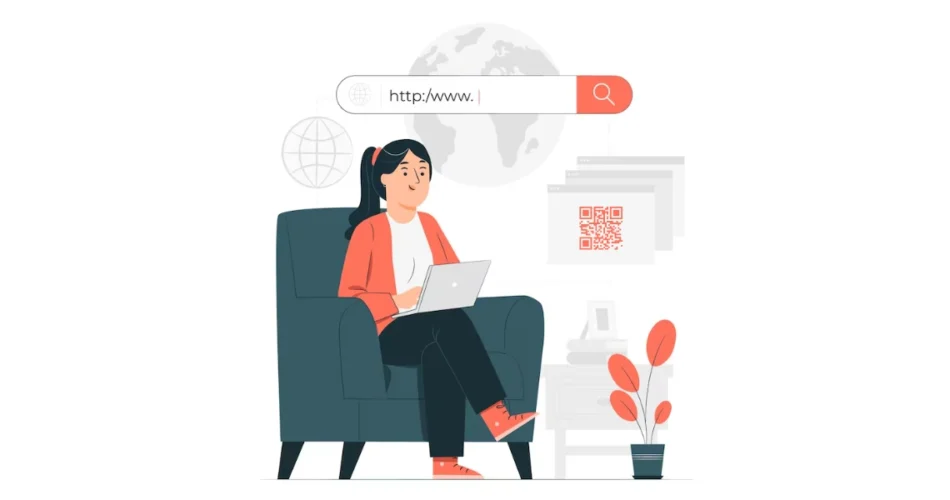TinyURL is a handy tool for shortening URLs, but did you know that these shorter connections can also be used to create QR codes?
Because consumers can scan QR codes with their phones, sharing URLs is more straightforward.
For each URL that is shortened, TinyURL automatically generates a QR code.
This post will explain how to create Tiny URL QR Codes and more.
Now, let’s get started!
A. A quick look into Tiny URL QR Codes

TinyURL’s well-known URL shortening service condenses lengthy, unwieldy links into short, accessible URLs.
The service’s ability to automatically generate QR codes for these abbreviated URLs is noteworthy.
Users only need to click to turn their TinyURL into a QR code that can be shared in presentations, digital platforms, or print.
B. How to create a tiny URL QR Code
1. Open your preferred web browser and go to tinyurl.com
2. From the homepage, type or paste the URL that you want to shorten
3. Now tap on the Shorten URL button
4. When you get the URL, you will also see an option for QR
5. Tap on it, and you will see three different formats to download it in
6. Choose your preferred format and download the QR
7. Now, test your QR before sharing it with the world
C. How to maximize the potential of your tiny URL QR Code
To maximize the potential of your tiny URL QR Code, you need to create a dynamic QR Code.
What are the advantages of a dynamic QR Code over a static one? Well, here you go:
1. Content flexibility
Dynamic QR Codes allow you to update the content they link to without changing the code. This is useful for campaigns where information, such as promotions, event details, or product information, may change over time. It eliminates the need to print new codes for every update.
2. Analytics and tracking
One of the key benefits of Dynamic QR Codes is the ability to track user engagement. You can monitor how many people scanned the code, where and when it was checked, and what device was used. This provides valuable insights for optimizing marketing strategies.
3. Reduced risk of obsolescence
Because the content behind a Dynamic QR Code can be updated, there’s less risk of the code becoming outdated. Even if the original content is no longer relevant, you can redirect users to new or updated information, ensuring longevity for long-term campaigns.
4. Customization options
Dynamic QR Codes are often more customizable than static ones. You can design the codes to incorporate brand colors, logos, or other elements, making them more visually appealing and consistent with your brand identity. Some platforms even allow dynamic content changes based on user location or device.
5. Enhanced security features
Dynamic QR Codes can offer better security. They can password-protect content or set expiration dates for certain links. This is particularly useful for sensitive information or limited-time promotions.
D. How to create a customized tiny URL using Scanova

Using Scanova for a demo, here’s how to create a tiny URL QR Code:
1. Go to Scanova. Click on Create QR Code
2. For demo purposes, select the Website URL category from amongst other QR Code categories
3. Since it’s a dynamic QR Code, a short URL will automatically be generated (which is the redirecting URL)
4. Now, click Continue
5. On the page that loads, name the QR Code and click Create QR Code
6. Next, you’ll see the preview of the QR Code along with the Edit Design button
7. If you click on it, you’ll see two QR Code designs—a Custom Logo and a Custom Background Design. Custom logo design allows you to add a logo and color to your QR Code. On the other hand, a custom background design helps you place a QR Code on any image
Note that a customized QR Code attracts more scans than a black-and-white one. Hence, to attract maximum scans, design your QR Code.
8. Once your QR Code is ready, you can preview it after you design it. If everything looks OK, proceed to download.
9. To download the QR Code, create an account. Here, Sign Up to get started with a 14-day free trial.
10. Once you Sign Up, click on the download icon. A pop-up will prompt you to specify the QR Code image size and format.
11. You can select your preferred image format. Also, you can enter the custom size of your QR in inches, pixels, millimeters, or centimeters to get your desired size
12. Once you enter the details, click Export
That’s it. Your tiny URL QR Code is ready. Simply test it once before you go ahead and share it with the world.
E. Benefits of a short URL QR Code

Using Tiny URLs in QR Codes provides several practical benefits that enhance user experience and functionality. Here are the key advantages:
1. Simplified QR Code design
Tiny URLs, shortened versions of long web addresses reduce the amount of data that needs to be encoded.
This results in QR Codes with simpler designs, fewer pixels, and a cleaner look. These are easier for cameras and scanners to read, reducing scanning errors.
2. Editable URLs
Some URL shortening services allow you to update the destination URL after creating the QR Code.
This flexibility is essential for situations where you might need to change the target link without reprinting the QR Codes.
3. Enhanced security and trust
Long, complex URLs can look suspicious or untrustworthy. A recognized short URL service can offer users more confidence when scanning QR Codes.
4. Faster loading times
Shorter URLs encode fewer characters, making the QR Code easier and faster for devices to process, resulting in quicker redirection to the target page.
5. Cost-effective for large campaigns
In print marketing, having less complex or smaller QR Codes can save space on materials, potentially reducing printing costs.
Additionally, if you use dynamic URLs, you won’t have to reprint materials if the link changes.
6. Versatility in use cases
Tiny URLs in QR Codes are useful across a variety of media like flyers, banners, emails, and digital screens, providing flexibility for different marketing strategies.
TinyURL’s HTTPS (secure links) usage for its QR Codes and shortened URLs reduces the risk of being flagged as unsafe or malicious.
F. Use cases: Where and why to implement tiny URL QR Codes

Tiny URL QRs can be implemented in various industries and use cases to enhance user engagement, track interactions, and improve the overall efficiency of marketing and operational activities.
Here are some specific use cases and reasons for implementing tiny URL QR Codes:
1. Event management
– Ticketing and check-ins: QR Codes with tiny URLs can simplify ticket distribution and scanning for event entry. Organizers can dynamically update the event details by embedding tiny URLs without reprinting tickets.
Tiny URL QR Codes also reduce complexity, speeding up the check-in process.
– Event agendas: Use tiny URL QR Codes on printed programs to link attendees to real-time, dynamically updated event agendas or maps. If there are changes to the schedule, the shortened link can be updated easily.
2. Restaurants and hospitality
– Menu access: Tiny URL QR Codes can be placed on tables or menus, allowing customers to access a digital menu or order online quickly.
If a menu needs updating, the dynamic URL ensures no need to replace the physical QR Codes.
– Customer feedback: Use tiny URL QR Codes on receipts or table cards to direct customers to an online survey or feedback form.
Restaurants can track how often these codes are scanned and adjust customer service based on the data.
3. Marketing and advertising
– Posters and flyers: Use tiny URL QR Codes in advertisements to link potential customers to landing pages, special promotions, or product launches.
The smaller code size ensures better scannability and more space for other design elements.
– Billboards and outdoor ads: In large-format print advertising, such as billboards, more minor QR Codes are more easily scannable from a distance.
The tiny URL also makes tracking engagement easier across various locations.
– Social media campaigns: Marketers can use QR Codes with shortened URLs in social media posts to drive traffic to websites, promotional pages, or specific social media accounts. The trackable nature of tiny URLs provides valuable insights into engagement levels.
4. Healthcare
– Patient information: Clinics and hospitals can provide tiny URL QR Codes on brochures, medication packaging, or posters that lead to patient education materials, appointment scheduling platforms, or telemedicine services.
– Contactless check-ins: For health and safety, tiny URL QR Codes can be used to allow patients to check in or fill out forms electronically via their smartphones.
5. Real estate
– Property listings: Real estate agents can place tiny URL QR Codes on yard signs or brochures, linking prospective buyers to property details, virtual tours, or contact forms. If a property listing changes, the QR Code can still be used by updating the shortened link.
– Open house check-ins: Tiny URL QR Codes can be used during open houses to collect visitor information or direct them to floor plans and other property-related documents.
QR Codes generated from TinyURL can be easily scanned and are compatible with nearly all smartphone cameras, making them versatile and functional across global markets.
6. Education and training
– Classroom materials: Teachers and instructors can use tiny URL QR Codes in worksheets or presentations, directing students to additional resources, assignments, or videos. This simplifies the process of sharing links without overwhelming students with long URLs.
– Virtual learning: In e-learning settings, QR Codes can guide students directly to lesson modules or assessment platforms. The dynamic link capability allows for updating course content without re-issuing codes.
7. Manufacturing and logistics
– Inventory management: QR Codes with tiny URLs can be used on product labels to link to real-time inventory systems, helping employees track shipments and product statuses.
– Product instructions: Manufacturers can include tiny URL QR Codes on packaging or manuals that direct users to detailed product instructions or how-to videos.
8. Business cards and networking
– Digital business cards: Tiny URL QR Codes can be added to business cards, directing people to a digital contact card, LinkedIn profile, or personal website. A smaller QR Code ensures the card remains professional and uncluttered.
– Networking events: At trade shows or networking events, QR Codes can be used to quickly exchange contact information or link to a personal portfolio, allowing follow-ups without needing physical cards.
9. Government and public services
– Public announcements: Government agencies can use tiny URL QR Codes in public service announcements to link citizens to updated information, application forms, or resources.
– Citizen surveys: QR Codes can be used in public campaigns to gather feedback on local government services. Tiny URLs allow for tracking and quick updates to the survey forms.
What our customers say about us
G. Integrating QR Code short URL into your marketing strategy

Tiny URL QR Codes can help you reach more people and track your campaign’s success. Here’s how to use them effectively:
1. Define your goal
First, decide what you want your QR Code to do. This could be anything from driving traffic to your website to promoting a special offer, boosting app downloads, or gathering customer feedback.
You must set measurable KPIs like the number of scans or purchases to determine your results.
2. Choose a URL shortener
You can use tools like Bitly to shorten your URL. To track your QR data, you can use Scanova’s dashboard to view all the analytics.
3. Design the QR Code
You must design your QR Code well to get good scan rates and responses. Do add your brand’s colors and logos for a professional look.
Also, do not forget to add a clear call-to-action for more impact.
4. Distribute QR Codes across channels
Just creating your QR Codes does not make them effective. You need to share them with the world for them to have an impact.
Start by putting them on flyers, brochures, or product packaging.
Include them in your social media, emails, or website for more reach.
The possibilities to share your QR are endless, you just need to find the right channels.
5. Run targeted campaigns
QRs can be beneficial if you offer customers discounts or sign them up for a loyalty program. You can even direct your users to surveys or special landing pages.
6. Test before launching
You don’t want faulty QRs making their way to your customers. So test the QR on all working devices, like iPhones and Androids. Also, test the link and ensure that it is mobile-friendly.
7. Track and optimize
Tracking and optimizing your QR Codes is key. So, monitor the user actions and the number of scans. To compare different QR Code designs, use A/B testing.


H. Best practices: Tiny URL QR Code

1. Shorten long URLs for clean codes
Use a short link to make your QR Code easier to scan. Long links create messy patterns that are harder to scan.
2. Print in high quality
Print your QR Codes in clear, high resolution. If the code is blurry, people won’t be able to scan it.
3. Keep the design simple
Don’t clutter the QR Code with too much design or information. A clean design makes it easier to scan.
4. Test scanning distance
Check how far away someone can scan the code. Bigger codes are better for far distances, like on large posters or billboards.
5. Give a backup option
Include a short link along with the QR Code. This way, people can still visit your site if they can’t scan the code.
6. Add simple instructions
Not everyone knows how to use QR Codes. Add clear steps like “Open your camera and point it at the code” to help people.
7. Make sure the page loads fast
The page your QR Code links to should load quickly. If it takes too long, people will leave before seeing your content.
8. Use QR Codes for special offers
QR Codes work great for limited-time offers or events. With short links, you can update the content without printing new codes.
9. Look at the data to improve
Keep an eye on your scan data. See which codes get the most scans and use that info to make better decisions.
10. Give people value
Ensure the QR Code leads to something useful, like a discount or special info. People are more likely to scan if there’s a real benefit.
Brands that trust us:
Summing Up
Let’s face it—marketing today is all about making things easy for your audience. Tiny URL QR Codes are a game changer. They make life simple for marketers and business owners in multiple ways.
Ready to give it a try? Start using Tiny URL QR Codes in your marketing strategy today and see how it can impact your bottom line. You’ve got this!


